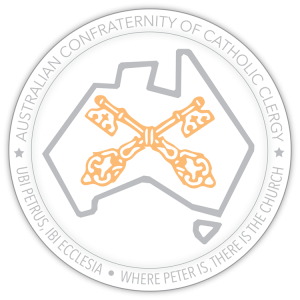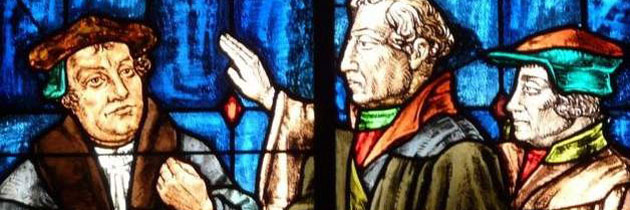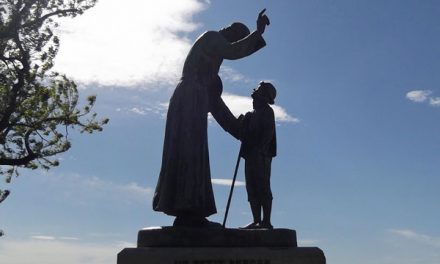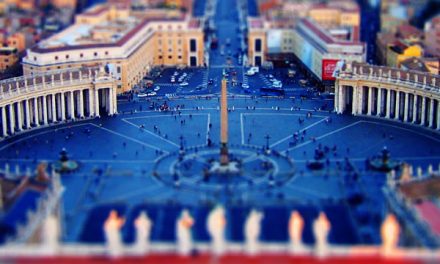These articles derive from a paper Fr Peter Joseph tabled at the 2012 ACCC Conference, Grace and Justification: Trent and later controversies.
The great controversies that would ensue in the decades and centuries after Trent were focused not on sanctifying grace but actual grace and its divisions and nature and efficacy and distribution, its compatibility with free-will, and so on. The more you read on the topic, the more confused you become. Only great minds could pretend to have mastered the controversy, but diligent study will enlighten you on some aspects of it.
A theologian in Paris I have mentioned already, called Michael de Bay – better known by his Latin form, Baius – had 79 errors on the nature of man and of grace condemned by Pope Pius V in 1567—only 4 years after the Council of Trent had closed.{{18}} Baius was a rigid Augustinian and his thinking would lead eventually to what we call Jansenism, sparked by the posthumous work Augustinus (1640) of Bishop Cornelius Jansen (d. 1638).
Baius taught an attenuated form of Protestantism:
- The grace accorded to Adam was due to nature, and hence did not exceed the requirements of nature.
- Faith is therefore necessary even for natural good, so that all the virtues of infidels are vices.
- Sanctifying grace is so necessary that all the works of sinners are sins.{{19}}
Jansenism retained these errors in substance, as evident from the 5 propositions of Jansen, condemned in A.D. 1653. (DS 2001-5)
Followers of the ideas of Baius at the Universities of Louvain and Douai became such fierce opponents of the Jesuits, that one of the great Jesuit theologians, the holy and learned Fr Lessius, a friend of Bellarmine, lamented in 1588: “I doubt whether Catholics were ever so zealous in opposition to heretics as the Louvain and Douai theologians are against us [Jesuits]”.{{20}}
The schools of thought developed over how to reconcile two things which all Catholics must accept:
- God does not ask the impossible, and sincerely wills the salvation of all (contrary to Protestantism, Calvin, Baianism, Jansenism).
- As Christ said, “Without Me, you can do nothing.” St Paul said, “What have you that you have not received.” (1 Cor 4:7). St Thomas says,{{21}} “Since God’s love is the cause of things’ goodness, nothing is in any respect better if God does not will greater good to one than to another.”{{22}} (Contrary to Pelagianism, and all forms of presumption).
Garrigou-Lagrange says: “These two principles are most certain, but their intimate reconciliation remains hidden, for it is the intimate reconciliation of infinite mercy, infinite justice, and supreme liberty in the sublime depth of the Deity.”{{23}}
Then comes the argument over the actual graces given to all men for salvation, and the mystery of consent to grace and dissent from grace.
Molina
That argument was sparked ironically by a book whose title opens with the word, Harmony: Concordia liberi arbitrii cum gratiae donis: “The Concord (or Harmony) of Free Will with the Gifts of Grace.” After thirty years of wrestling with the deep problems of grace, free-will and predestination, the Spanish Jesuit, Father Luis Molina, issued this book in 1588. It has been described as profound but badly written.{{24}} It had passed the Portuguese Dominican censors in Lisbon where it was printed.
On one side of the mammoth controversy that ensued was Father Molina, and his defenders – and opposite him was the charge led by Father Domingo Banez (not Baius – a different man). Banez was an eminent Dominican theologian at Salamanca in Spain, well-known also as a defender and spiritual director of St Teresa of Avila. But, unlike her, he had a great antipathy to the Society of Jesus.
“Grace is intrinsically efficacious”—was the proposition upheld by Banez, and those who proudly called themselves “Thomists”.
“Grace is not intrinsically efficacious”—was the proposition upheld by Molina, his Jesuit supporters, Suarez, and others, some of whom also claimed to be Thomists.
Long before this controversy, St Ignatius had written, in his Rules for Thinking with the Church, at the end of the Spiritual Exercises: “We ought not to speak of, or to insist on the doctrine of grace so strongly as to give rise to that pernicious teaching that takes away free-will. Hence, we may treat of faith and grace … but not in such a way, especially in these dangerous times of ours, that works or free-will receive any detriment or come to be accounted for nothing.” (no. 17 of 18 Rules)
In another of these Rules, Ignatius advises preachers and writers to be careful: not to speak much of predestination lest one induce fatalism, and negligence in works which lead to salvation.
Background on Bellarmine
Now I must admit that I learnt first about this controversy via Father James Brodrick’s biography of St Robert Bellarmine (1542-1621) – and so from that Jesuit point of view, I broadly saw the Jesuits in the right and the Dominicans in the wrong. “Broadly” only, because I adopted the viewpoint of Bellarmine (my hero and Confirmation patron) who never sided with either party completely. He was one of the few in that intense controversy who looked to doctrines and not personalities, who looked for the truth, regardless of who said it. In some things he regarded the Jesuit Molina as mistaken, and in other points, he regarded the Dominican Banez as mistaken.
When the first volume of Bellarmine’s Controversies of the Christian Faith was issued in 1586, it overwhelmed the enemy with its erudition, exhibiting such extraordinary knowledge of the Scriptures, Fathers, Councils, theologians, historians, philosophers, humanists and Protestant writers—so that a French Calvinist theologian, François du Jon (Junius), charged that “Bellarmine” was not a real man at all, but a pen-name used by a team of scholars: “Methinks it is not one Bellarmine who speaks in these pages,” said the man in his panic. “It is the whole Jesuit phalanx, the entire legion of them mustered for our destruction.”{{25}}
In the Controversies, Bellarmine was so extraordinarily fair in argument, accurately presenting each objection its full force before demolishing it, that some Catholics charged him with furnishing arguments to the Protestants, for he put their arguments better than they could themselves!{{26}}
Unable to respond with arguments, in England they gave the name of bellarmines to a type of pot-bellied jug with the effigy of a bearded man at the top and spout. The design was originally a French one, and there they had a different name, but in England, as a form of mockery of him, they fancied it resembled St Robert—and it became known as the bellarmine. There are hundreds from the 16th century. I saw one once on display.{{27}}
Of course, many mediocre Jesuits live off the reputation of the brilliant ones in their Society. I remember an Indian nun telling me that in her city (in India) a woman asked a Jesuit priest about her son, who wanted to be a priest, and where she should recommend him to go. The Jesuit priest advised her: “Well, the diocesan priests study for 6 years before ordination; the Dominicans study for about 8 years before they are ordained; the Salesians sometimes do even more and are not ordained till possibly 10 years after entering the novitiate; whereas the Jesuits have the longest study of all: we are not ordained till 12 or 13 years after becoming novices.” “Well,” the mother said, “I think the Jesuits will suit my son best – because he is a bit of a slow learner”!
The conduct of the controversy
Back to the theological controversy! – In his life of Bellarmine, Brodrick says that Bellarmine and Lessius strove “to show how the will’s freedom remains intact even under the impulsion of efficacious grace, an article of Catholic faith fiercely attacked by Lutherans, Calvinists, Baianists and [later] Jansenists alike” (p. 191)
Here are some sentences from Molina’s Concordia which aroused the ire of Banez and other Dominicans:
“It may happen that a person anticipated and called with greater help by far, is not converted on account of his free will, while another with far less [help] is converted.” (p. 51)
“With equal help it may happen that one of those called is converted and the other is not.” (p. 656, 617)
“A person aided by less help from grace may rise, while another with more help does not, but continues in his obduracy.” (p. 618)
Molina’s idea was that “sufficient grace” is rendered “efficacious grace” by our consent.
Now, my reaction, when first hearing these propositions (years ago) was to say: “That’s sounds reasonable.” After all, Our Lord Himself said, “Alas for you, Tyre and Sidon, if the miracles done in you had been done in Sodom and Gomorrah, they would be standing yet.” (Matt 11:21) What converts one fails with, or would fail with, another.
But these sentences were condemned by some theologians, as Garrigou-Lagrange in the twentieth century condemned them,{{28}} as denying the efficacious nature of grace. Garrigou and Banez and others teach that efficacious grace is efficacious of its own intrinsic nature, that it works infallibly on the person, while the person remains free.
In 1594, six years after Concordia was published, the Apostolic Nuncio in Spain wrote to Rome, asking for an intervention over the controversy. By that time, the Dominicans in Spain, in their public discourses and lectures, were calling the Jesuit teaching heretical and the members of that Order as tainted with heresy. The Nuncio was instructed to tell the superiors of the Jesuits and Dominicans that the whole affair had been taken over by the supreme tribunal of the Church, that they were to present their respective cases to Rome, and, pending a decision, were, by Pope Clement VIII’s express command, to refrain from all further discussion, private and public, of the matter in dispute.
Father Robert Bellarmine (not a Cardinal until 1599) wrote a private report on the controversy, at the Pope’s request. On the question of efficacious grace, Bellarmine said there are 3 opinions.
- Some scholastics taught that actual grace owes its efficacy to the consent of the will, and Molina seems to agree with them. They uphold this so as to preserve the sufficiency of sufficient grace and the freedom of the will. St Robert said “This opinion seems to me to be false and rightly reprehended in the censure of the Dominicans.”
- The efficacy of grace in no way depends on the consent of the will, but that consent is physically and intrinsically determined by grace, physically in the sense that it wreaks its effects by its own nature, physis. The Dominicans teach this because they think this was held by St Thomas, and that the true efficacy of grace cannot be defended on any other hypothesis. “It seems to me to be no less false and dangerous than the first opinion; … it destroys sufficient grace … it appears to contradict the Council of Trent (Session 6: chapter 5, and canon 4 [Decree on Justification: where it speaks of man’s free will under the influence of grace] … this opinion does not seem to save free will, nor can it be distinguished from the expressions used by the modern heretics. … I do not, however, dare to condemn it absolutely, as I know it is defended by great men,” said St Robert. Bellarmine believed it was not taught by St Thomas, and that according to this theory, God would be the cause also of men’s sins as well as their virtuous deeds.{{29}}
- Bellarmine, like his friend Lessius, believed both opinions to be wrong. They believed the difference between sufficient and efficacious grace lay in another factor, namely, the circumstances accompanying its bestowal. If the same help or grace is accorded to two persons, with the result that one resists temptation while the other does not, then this is due to the fact that the person who avoided sin received the impulse of grace in the manner and place and time which God saw were suited or congruous to his dispositions and would unfailingly lead to acceptance. The sufficient grace is not so perfectly suited to the person’s character and circumstances. Suarez and Vasquez and many others adopted this school of thought that became known as Congruism.{{30}}
Molina spoke, as all theologians spoke, of God’s scientia simplicis intelligentiae – God’s simple knowledge of whatever is possible; and the scientia visionis – His knowledge of whatever is real, including what is future to us. He added a third knowledge, scientia media, a mid-way knowledge by which God knows what choices a free agent would make in any conceivable set of circumstances.
A key term on the Dominican side was praemotio physica. But if I am not mistaken, the term praemotio physica, physical predetermination or intervention, adopted by the Thomists to designate divine action upon the soul, is not in St Thomas at all. Hence, some theologians say “Banezians” rather than “Thomists” teach this physical intervention or determination by God.{{31}}
The end of the affair
In 1597, Pope Clement VIII appointed a special seven-man commission in Rome, the “Congregatio de Auxiliis,” to deal with the disputes on the manner in which divine grace operates. The name “de Auxiliis” means “concerning helps” – i.e., divine helps to salvation. The Congregation reported for the first time on 19 March 1598, advising that the circulation of Molina’s book be forbidden and 61 propositions extracted from it be condemned—but the Pope declined to ratify the decision. One reason for the Pope’s reticence was that they had reached a decision within 3 months, whereas at the same time a big wooden box of relevant materials, memoranda, books and pamphlets had been brought to Rome by Spain, and the Pope knew the commission could not possibly have done a thorough job of examination. They reduced the offending propositions to be censured to 42, but still no Papal confirmation came. Eight months later, in 1600, when the number of offending propositions had been reduced to 20, a third attempt to secure Papal condemnation also failed. In 1601, in the midst of this intense and bitter controversy which had public once again, Cardinal del Monte had a little conversation with Cardinal Bellarmine (now a Cardinal since 1599):
Del Monte: I believe His Holiness is going to issue a definition on this matter of efficacious grace.
Bellarmine: His Holiness will do no such thing.
Del Monte: Why are you so sure, Your Eminence? You must admit the Pope has the power to define the question, and I know that his mind is made up to define it.
Bellarmine: Yes, he has the power but he will not exercise it.
Del Monte: How on earth do you make that out?
Bellarmine: Because he will die before he gets the opportunity.
Next day, Cardinal Bellarmine wrote a letter to the Pope, whose theologian he was, earnestly urging him not to try to resolve a complex tangled question imprudently by his private lights.
Perhaps this led to the multiple meetings of the special Congregatio. Between 1602 and 1605, there were 68 sessions held of the Congregatio de Auxiliis, and, in addition, the matter was thrashed out in 37 debates conducted before the Congregation.
Molina died in 1600. In 1603, Pope Clement died, without having ruled on the controversy. Then came Pope Leo XI, who reigned only a few weeks. Cardinal Borghese, closely connected with the dispute, succeeded him as Pope Paul V, while the Congregatio continued its meetings and debates. Banez died in 1604. At a crucial time, in December 1604, Cardinal du Perron, from France, a convert from Calvinism, came to Rome and spoke frankly to Pope Paul V: “If Your Holiness forbids as erroneous the Jesuit method of reconciling grace and free-will, all the Calvinists and Lutherans of France and Germany will applaud your sentence, and see in it a formal approbation of their own sentence.” Being neither Dominican nor Jesuit, his opinion could be accepted as that of a non-interested party.
Finally, two years into his Papacy, on 28 August 1607, feast of St Augustine, the Doctor of Grace, the Pope asked each of the eight cardinals of the Congregatio for their opinion. Only one, a Dominican, was firmly in favour of a condemnation of Molina. The other seven, of varying personal opinions, favoured no condemnation of either side. On 5 September 1607, Pope Paul V gave his final decision. He decreed that both sides were free to teach their respective doctrines, and that mutual recriminations were to cease: that the Dominicans could not call the Jesuits “Pelagians,” and the Jesuits could not call the Dominicans “Calvinists.” That decision was exactly what St Robert Bellarmine had recommended to the previous Pope ten years earlier.
The authority of St Augustine
The argument over predestination and grace and liberty went back to the early Church. About 400 A.D., a non-ordained monk named v, of Irish or Scottish extraction, attacked the dogma of grace and became exasperated one day when he heard a bishop quote Augustine’s saying: “Da quod jubes et jube quod vis.” “Grant what You command, and command what You will.”{{32}} Different African local Councils, and Bishops, including Augustine, wrote to Rome, asking for a condemnation of the doctrines of Pelagius and his supporters, which they had already condemned locally.
In the sixteenth and seventeenth century controversy over grace, both sides claimed to be true to Saint Augustine, and that the other side was not. Since that time, the Church has had to declare the limits of St Augustine’s authority against those who make his writings an absolute rule of faith. The Jansenists, for example, did say that a single phrase from Augustine must be preferred to the most solemn decisions of the Church. Cornelius Jansen himself laid the foundations of this absurdity in the second volume of his book Augustinus with repeated chapter titles, “The evangelical, apostolic teaching of Augustine on God’s grace, unsurpassed in authority, written in the name of the whole Church, with the silent consent of all other authors.”{{33}} When he found in Augustine the 53rd proposition of Baius condemned by the Pope, Jansen refused to condemn it, but said that the Pope must have condemned it—not as false, for Augustine’s teaching is always true—but because it was “disturbing the peace”.{{34}} A later Jansenist, Havermans, formulated proposition 30 among Jansenist errors condemned by the Holy Office under Pope Alexander XII in 1690: “Whatever doctrine one finds clearly founded in Augustine can be held and taught absolutely, without regard for any Apostolic Bull.”{{35}} During the controversies De Auxiliis, the Molinists were accused by Diego Alvarez of not accepting the following principle in its full rigor: “Any teaching of Augustine on grace or predestination must be considered as a dogma of the Catholic Church.”{{36}}
St Thomas says however, in the Summa Theologica: “The custom of the Church has very great authority and ought to be jealously observed in all things, since the very doctrine of Catholic Doctors derives its authority from the Church. Hence, we ought to abide by the authority of the Church rather than by that of an Augustine or a Jerome or of any Doctor whatever.”{{37}}
Molina uncensured
The full title of Fr Molina’s book was:
Concordia liberi arbitrii cum gratiae donis, divina praescientia, providentia, praedestinatione, et reprobatione, ad nonnullos primae partis D. Thomae articulos (Olyssipone [Lisbon] 1588, Apud Antonium Riberium typographum regium. 512 pages & indices).
“The Harmony of Free Will with the Gifts of Grace, Divine Foreknowledge, Providence, Predestination, and Reprobation, according to several articles of the First Part [of the Summa] of St Thomas.”
You can see the whole original book online on Google books. The book is divided into questions, articles and disputations. I saw too the title of a book printed a few years ago: someone had translated its fourth part into English.
In the end, Molina’s book was never censured by the Holy See in any way, and when the final decision of 1607 allowed his opinions to be taught, and he had escaped the censure so ardently sought by so many enemies, in Spain at Salamanca University, Spanish Jesuits or their friends posted bills on the walls of Salamanca with two jubilant words: MOLINA VICTOR ! In other towns they had masques and fireworks to celebrate. In Villargarcia, the Spanish Jesuits had a bull-fight to celebrate the occasion!
[[18]]Propositions of Baius condemned in the Bull Ex omnibus afflictionibus: DS 1901-1980.[[18]]
[[19]]Taken from Garrigou-Lagrange, Grace, p. 17.[[19]]
[[20]]James Brodrick S.J., Robert Bellarmine – Saint and Scholar (Newman Press, Maryland 1961) p. 190.[[20]]
[[21]]Summa, I, q. 20, art. 3.[[21]]
[[22]]Garrigou-Lagrange, Grace, p. 18.[[22]]
[[23]]Garrigou-Lagrange, Grace, pp. 18-9.[[23]]
[[24]]My account of the dispute and some of the quotations below come from Brodrick’s Bellarmine, chapter VII – or from chapter XIX of his larger 2-volume biography of Bellarmine: The Life and Work of Blessed Robert Francis Cardinal Bellarmine, S.J. 1542-1621 (Burns Oates and Washbourne, London 1928).[[24]]
[[25]]Brodrick, Bellarmine, p. 76.[[25]]
[[26]]Brodrick, Bellarmine, p. 76.[[26]]
[[27]]Brodrick, Bellarmine, p. 87.[[27]]
[[28]]Grace, pp. 419-20.[[28]]
[[29]]Brodrick, Bellarmine, pp. 199-200.[[29]]
[[30]]By the twentieth century, Tanquerey could say, “However, few teach this system today.” Brevior Synopsis Theologiae Dogmaticae (7th ed. Desclée, Paris 1931) par. 935, p. 547.[[30]]
[[31]]“The Thomistic Theory of Grace. – The true founder of the Thomistic system is not St. Thomas Aquinas, who is also claimed by the Molinists, but the learned Dominican theologian Bañez (1528-1604).” Pohle-Preuss, Grace Actual and Habitual (Dogmatic Theology, vol. VII: 1924. Herder, London 12th impression, 1946) p. 232.[[31]]
[[32]]De dono perseverantiae, bk I; four times in book X of Confessions.[[32]]
[[33]]Eugène Portalié S.J., A Guide to the Thought of Saint Augustine (Henry Regnery Co., Chicago 1960) p. 322 [a trans. of his article “Augustine, Saint” in Dictionnaire de Théologie Catholique, tom. I, col. 2268-2472, Letouzey, Paris 1902].[[33]]
[[34]]Augustinus, ch. 30.[[34]]
[[35]]DS 2330.[[35]]
[[36]]Portalié, A Guide to the Thought of Saint Augustine, p. 323.[[36]]
[[37]]II-II, q. 10, art. 12, c.[[37]]






